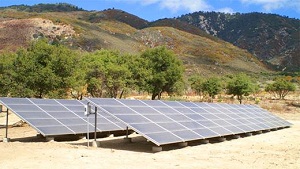Energy leaders talk solar on Native lands
 While there are Indian reservations scattered throughout the country, the Southwest is home to many. That simple fact makes solar and other renewable energy development discussions extremely relevant to native peoples.
While there are Indian reservations scattered throughout the country, the Southwest is home to many. That simple fact makes solar and other renewable energy development discussions extremely relevant to native peoples.
The best areas in the country for solar development also happen to be where the highest concentration of Indian reservations is located, said Carolyn Stewart, managing partner and owner of Red Mountain Energy Partners. Stewart moderated a discussion between energy-industry leaders and Native American leaders at the Global New Energy Summit in Colorado Springs last week.
The discussion centered on the vast natural resources available on tribal lands and the infinite challenges to develop them. Because most incentives for solar and wind development are tax-related, they don’t work for tribal lands, Stewart said.
Many of the native peoples living on Indian reservations suffer high unemployment and poverty rates, she said, and haven’t found a way to generate meaningful income. Even those reservations with gambling operations don’t see a lot of success unless they are located near a city, she said.
For some, energy could be the answer.
Rob Thompson, shareholder and chair of the Indian Lands Group noted that the natural resources available on tribal lands are extremely valuable if only infrastructure for promoting and financially supporting development can grow and if the physical infrastructure needed to connect these remote reservations to the main electrical grid can be constructed.
“Native Americans as a percentage of Americans,” Thompson said, “are energy exporters. They’ve already developed oil and gas reserves. Most of these tribes ended up where they are because they were pushed to areas that were unattractive for agrarian pursuits. If no one in this room believes in karma—lo and behold that sand was worth something after all.”
Tribal leaders also spoke about some of the renewable energy projects they are pursuing. Todd Hooks, the economic development director for the Agua Caliente Band of Cahuilla Indians, explained that his tribe, located in Palm Springs, operates a real estate economy. The tribal leaders determine the best land use on a case-by-case basis and have built major hotels, resorts and gaming facilities. Yet, they have maintained some lands free of development.
He said the tribe recently installed solar panels on the roof of its remote trading post located in a land section with no power lines. The post had previously gotten its power from a propane generator.
Bruce Valdez, executive director of the Southern Ute Indian Tribal Growth Fund, explained that his tribe, which has long been involved in energy pursuits, is currently exploring a wide variety of green energy development in the Four Corners region, including algae fuel cultivation and solar installations.
Pictured: A solar installation on the Cahuilla Tribe’s land. Image courtesy of DailyYonder.com



